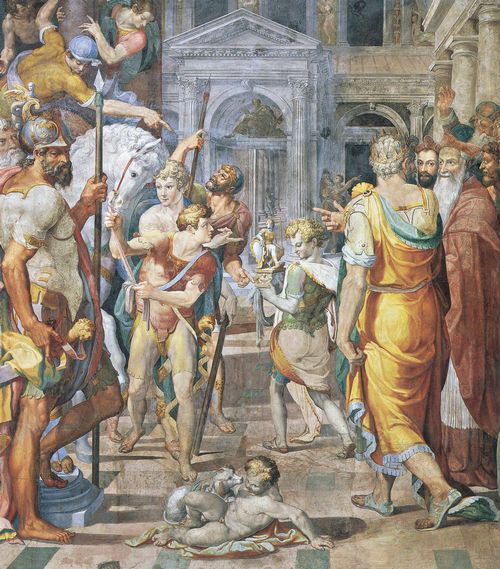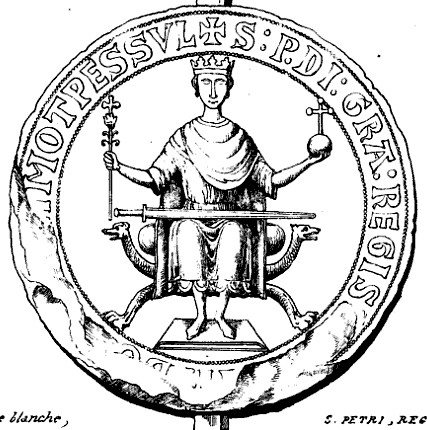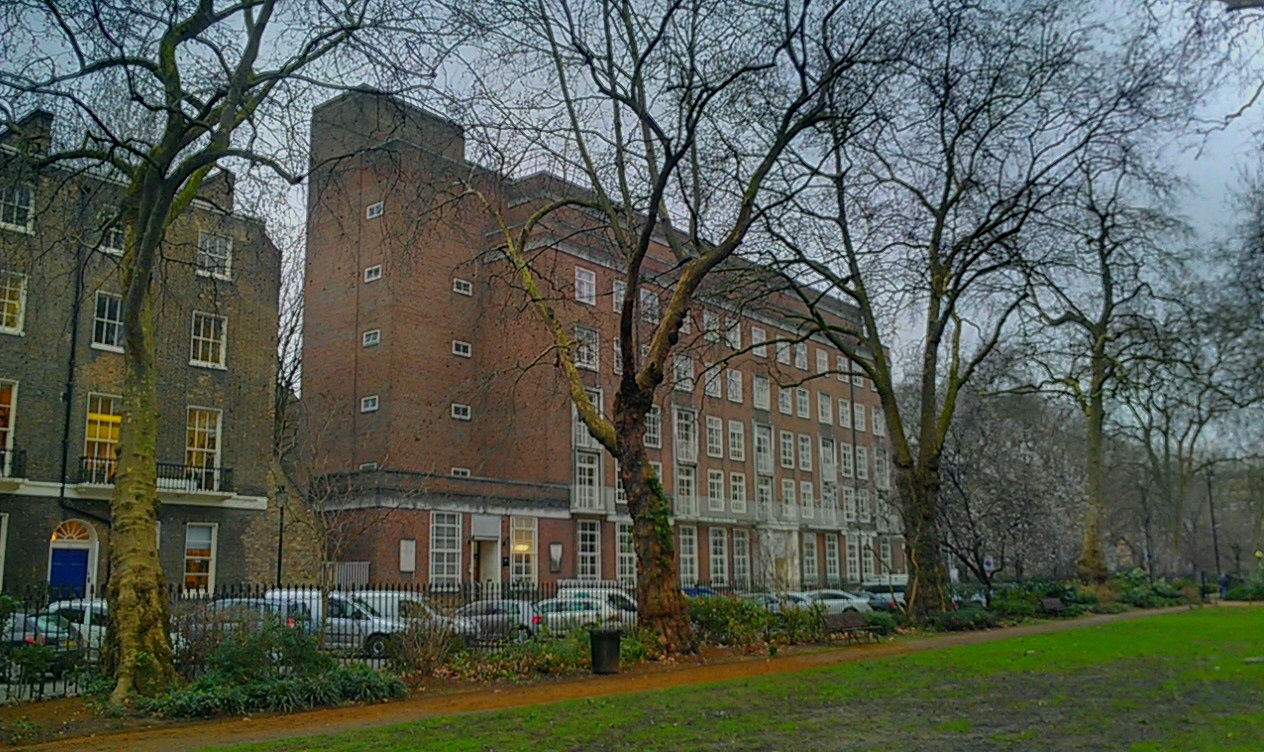|
Sala Regia (Vatican)
The Sala Regia (Regal Room) is a state hall in the Apostolic Palace in Vatican City. Although not intended as such, this broad room is really an antechamber to the Sistine Chapel. It also connects to the Pauline Chapel and is reached by the long staircase known as the Scala Regia. To the left of the entrance formerly stood the papal throne, which is now at the opposite side before the door leading to the Pauline Chapel. The hall was begun under Pope Paul III by Antonio da Sangallo the Younger and was completed in 1573. The elegant barrel vault is graced by the very impressive plaster decorations of Perino del Vaga. The stucco ornaments over the doors are by Daniele da Volterra. By 2019, the room and staircase were open to tourists who visit the Apostolic Palace. The walls were decorated by Livio Agresti, Giorgio Vasari and Taddeo Zuccari. The frescoes depict momentous turning-points in the history of the Church, including the return of Pope Gregory XI from Avignon to ... [...More Info...] [...Related Items...] OR: [Wikipedia] [Google] [Baidu] |
Sala Regia, 12
Sala or SALA may refer to: Places Europe * Sala, the historical name of the river IJssel and home of the Salii Franks * Sala (Estonian island), one of the Uhtju islands * Sala Baganza, a municipality in Emilia-Romagna, Italy * Sala Bolognese, a municipality in Emilia-Romagna, Italy * Sala Consilina, a municipality in Campania, Italy * Sala Municipality, Latvia, a municipality in Latvia * Sala, Sala Parish, a village in Latvia, an administrative centre of Sala municipality * Šaľa, Slovakia, a city in Slovakia * Sala Municipality, Sweden, a municipality in Sweden * Sala, Sweden, a city in Sweden, seat of Sala Municipality * Sala Parish (other), parishes (''socken'') in Sweden Africa * Salé ( ber, Sala, link=no), Morocco * Sala, an ancient city at Rabat, Morocco * Sala, Houet, a village in Satiri Department, Houet Province, Burkina Faso * Sala, Ziro, a village in Ziro Province, Burkina Faso * Sala Colonia, a Phoenician and Roman colony whose ruins are located i ... [...More Info...] [...Related Items...] OR: [Wikipedia] [Google] [Baidu] |
Livio Agresti
Livio Agresti (1508–1580), also called Ritius or Ricciutello, was an Italian painter of the late Renaissance or Mannerist period, active both in his native city of Forlì and in Rome, where he died. He was one of the members of the "Forlì painting school". Biography Initially a pupil of Francesco Menzocchi, in 1535 he painted the frescoes of the ''Eucharist'' and the ''Prophets'' for the Chapel of the Sacrament in Forlì Cathedral, now in the local art gallery, the Pinacoteca Civica di Forlì. In 1539, he painted in the Church of Santa Maria dei Servi. In 1542, he travelled to Ravenna, where he painted the canvas of ''Bishops'' now kept in Ariani Cathedral. He joined the Roman Accademia di San Luca in 1534. In 1544, he painted the frescoes of allegorical figures in the ''Sala Paolina'' of the Castel Sant’Angelo in Rome, under the supervision of Perin del Vaga. Agresti also helped decorate the church of Santa Maria in Cosmedin in Rome. In 1555–6, he decorated the Gonzag ... [...More Info...] [...Related Items...] OR: [Wikipedia] [Google] [Baidu] |
Pope Innocent III
Pope Innocent III ( la, Innocentius III; 1160 or 1161 – 16 July 1216), born Lotario dei Conti di Segni (anglicized as Lothar of Segni), was the head of the Catholic Church and ruler of the Papal States from 8 January 1198 to his death in 16 July 1216. Pope Innocent was one of the most powerful and influential of the medieval popes. He exerted a wide influence over the Christian states of Europe, claiming supremacy over all of Europe's kings. He was central in supporting the Catholic Church's reforms of ecclesiastical affairs through his decretals and the Fourth Lateran Council. This resulted in a considerable refinement of Western canon law. He is furthermore notable for using interdict and other censures to compel princes to obey his decisions, although these measures were not uniformly successful. Innocent greatly extended the scope of the Crusades, directing crusades against Muslim Iberia and the Holy Land as well as the Albigensian Crusade against the Cathars in southern ... [...More Info...] [...Related Items...] OR: [Wikipedia] [Google] [Baidu] |
Peter II Of Aragon
Peter II the Catholic (; ) (July 1178 – 12 September 1213) was the King of Aragon and Count of Barcelona from 1196 to 1213. Background Peter was born in Huesca, the son of Alfonso II of Aragon and Sancha of Castile. In 1205 he acknowledged the feudal supremacy of the papacy and was crowned in Rome by Pope Innocent III, swearing to defend the Catholic faith (hence his epithet, "the Catholic"). He was the first king of Aragon to be crowned by the pope. In the first decade of the thirteenth century Peter commissioned the ''Liber feudorum Ceritaniae'', an illustrated codex cartulary for the counties of Cerdagne, Conflent, and Roussillon. Marriage On 15 June 1204 Peter married (as her third husband) Marie of Montpellier, daughter and heiress of William VIII of Montpellier by Eudocia Comnena. She gave him a son, James, but Peter soon repudiated her. Marie was popularly venerated as a saint for her piety and marital suffering, but was never canonized; she died in Rome in 1 ... [...More Info...] [...Related Items...] OR: [Wikipedia] [Google] [Baidu] |
Frederick Barbarossa
Frederick Barbarossa (December 1122 – 10 June 1190), also known as Frederick I (german: link=no, Friedrich I, it, Federico I), was the Holy Roman Emperor from 1155 until his death 35 years later. He was elected King of Germany in Frankfurt on 4 March 1152 and crowned in Aachen on 9 March 1152. He was crowned King of Italy on 24 April 1155 in Pavia and emperor by Pope Adrian IV on 18 June 1155 in Rome. Two years later, the term ' ("holy") first appeared in a document in connection with his empire. He was later formally crowned King of Burgundy, at Arles on 30 June 1178. He was named by the northern Italian cities which he attempted to rule: Barbarossa means "red beard" in Italian; in German, he was known as ', which means "Emperor Redbeard" in English. The prevalence of the Italian nickname, even in later German usage, reflects the centrality of the Italian campaigns to his career. Frederick was by inheritance Duke of Swabia (1147–1152, as Frederick III) before his i ... [...More Info...] [...Related Items...] OR: [Wikipedia] [Google] [Baidu] |
Pope Alexander III
Pope Alexander III (c. 1100/1105 – 30 August 1181), born Roland ( it, Rolando), was head of the Catholic Church and ruler of the Papal States from 7 September 1159 until his death in 1181. A native of Siena, Alexander became pope after a contested election, but had to spend much of his pontificate outside Rome while several rivals, supported by Holy Roman Emperor Frederick I Barbarossa, claimed the papacy. Alexander rejected Byzantine Emperor Manuel I Komnenos' offer to end the East–West Schism, sanctioned the Northern Crusades, and held the Third Council of the Lateran. The city of Alessandria in Piedmont is named after him. Early life and career Rolando was born in Siena. From the 14th century, he was referred to as a member of the aristocratic family of Bandinelli, although this has not been proven. He was long thought to be the 12th-century canon lawyer and theologian Master Roland of Bologna, who composed the "Stroma" or "Summa Rolandi"—one of the earliest comment ... [...More Info...] [...Related Items...] OR: [Wikipedia] [Google] [Baidu] |
Henry IV Of France
Henry IV (french: Henri IV; 13 December 1553 – 14 May 1610), also known by the epithets Good King Henry or Henry the Great, was King of Navarre (as Henry III) from 1572 and King of France from 1589 to 1610. He was the first monarch of France from the House of Bourbon, a cadet branch of the Capetian dynasty. He was assassinated in 1610 by François Ravaillac, a Catholic zealot, and was succeeded by his son Louis XIII. Henry was the son of Jeanne III of Navarre and Antoine de Bourbon, Duke of Vendôme. He was baptised as a Catholic but raised in the Protestant faith by his mother. He inherited the throne of Navarre in 1572 on his mother's death. As a Huguenot, Henry was involved in the French Wars of Religion, barely escaping assassination in the St. Bartholomew's Day massacre. He later led Protestant forces against the French royal army. Henry became king of France in 1589 upon the death of Henry III, his brother-in-law and distant cousin. He was the first Fre ... [...More Info...] [...Related Items...] OR: [Wikipedia] [Google] [Baidu] |
The Warburg Institute
The Warburg Institute is a research institution associated with the University of London in central London, England. A member of the School of Advanced Study, its focus is the study of cultural history and the role of images in culture – cross-disciplinary and global. It is concerned with the histories of art and science, and their relationship with superstition, magic, and popular beliefs. The researches of the Warburg Institute are historical, philological and anthropological. It is dedicated to the study of the survival and transmission of cultural forms – whether in literature, art, music or science – across borders and from the earliest times to the present including especially the study of the influence of classical antiquity on all aspects of European civilisation. Based originally in Hamburg, Germany, in 1933 the collection was moved to London, where it became incorporated into the University of London in 1944. History Hamburg The institute was formed in Hamburg ... [...More Info...] [...Related Items...] OR: [Wikipedia] [Google] [Baidu] |
Journal Of The Warburg And Courtauld Institutes
The Warburg Institute is a research institution associated with the University of London in central London, England. A member of the School of Advanced Study, its focus is the study of cultural history and the role of images in culture – cross-disciplinary and global. It is concerned with the histories of art and science, and their relationship with superstition, magic, and popular beliefs. The researches of the Warburg Institute are historical, philological and anthropological. It is dedicated to the study of the survival and transmission of cultural forms – whether in literature, art, music or science – across borders and from the earliest times to the present including especially the study of the influence of classical antiquity on all aspects of European civilisation. Based originally in Hamburg, Germany, in 1933 the collection was moved to London, where it became incorporated into the University of London in 1944. History Hamburg The institute was formed in Hamburg ... [...More Info...] [...Related Items...] OR: [Wikipedia] [Google] [Baidu] |
Battle Of Lepanto
The Battle of Lepanto was a naval engagement that took place on 7 October 1571 when a fleet of the Holy League, a coalition of Catholic states (comprising Spain and its Italian territories, several independent Italian states, and the Sovereign Military Order of Malta) arranged by Pope Pius V, inflicted a major defeat on the fleet of the Ottoman Empire in the Gulf of Patras. The Ottoman forces were sailing westward from their naval station in Lepanto (the Venetian name of ancient Naupactus – Greek , Ottoman ) when they met the fleet of the Holy League which was sailing east from Messina, Sicily. The Spanish Empire and the Venetian Republic were the main powers of the coalition, as the league was largely financed by Philip II of Spain, and Venice was the main contributor of ships. In the history of naval warfare, Lepanto marks the last major engagement in the Western world to be fought almost entirely between rowing vessels, namely the galleys and galleasses which were th ... [...More Info...] [...Related Items...] OR: [Wikipedia] [Google] [Baidu] |
Rome
, established_title = Founded , established_date = 753 BC , founder = King Romulus (legendary) , image_map = Map of comune of Rome (metropolitan city of Capital Rome, region Lazio, Italy).svg , map_caption = The territory of the ''comune'' (''Roma Capitale'', in red) inside the Metropolitan City of Rome (''Città Metropolitana di Roma'', in yellow). The white spot in the centre is Vatican City. , pushpin_map = Italy#Europe , pushpin_map_caption = Location within Italy##Location within Europe , pushpin_relief = yes , coordinates = , coor_pinpoint = , subdivision_type = Country , subdivision_name = Italy , subdivision_type2 = Region , subdivision_name2 = Lazio , subdivision_type3 = Metropolitan city , subdivision_name3 = Rome Capital , government_footnotes= , government_type = Strong Mayor–Council , leader_title2 = Legislature , leader_name2 = Capitoline Assemb ... [...More Info...] [...Related Items...] OR: [Wikipedia] [Google] [Baidu] |
Avignon
Avignon (, ; ; oc, Avinhon, label=Provençal dialect, Provençal or , ; la, Avenio) is the Prefectures in France, prefecture of the Vaucluse Departments of France, department in the Provence-Alpes-Côte d'Azur Regions of France, region of Southeastern France. Located on the left bank of the river Rhône, the Communes of France, commune had a population of 93,671 as of the census results of 2017, with about 16,000 (estimate from Avignon's municipal services) living in the ancient town centre enclosed by its Walls of Avignon, medieval walls. It is Functional area (France), France's 35th largest metropolitan area according to Institut national de la statistique et des études économiques, INSEE with 336,135 inhabitants (2019), and France's 13th largest urban unit with 458,828 inhabitants (2019). Its urban area was the fastest-growing in France from 1999 until 2010 with an increase of 76% of its population and an area increase of 136%. The Communauté d'agglomération du Grand Av ... [...More Info...] [...Related Items...] OR: [Wikipedia] [Google] [Baidu] |




.jpg)


